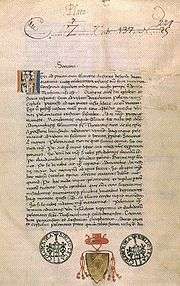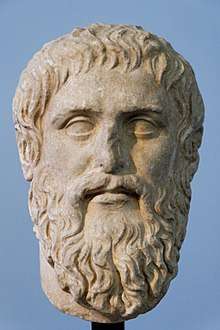Myth of Er
The Myth of Er is a legend that concludes Plato's Republic (10.614–10.621). The story includes an account of the cosmos and the afterlife that greatly influenced religious, philosophical, and scientific thought for many centuries.

The story begins as a man named Er (/ɜːr/; Greek: Ἤρ, gen.: Ἠρός; not to be confused with Eros: /ˈɛrɒs/; Greek: Ἔρως) son of Ἀρμένιος, Armenios of Pamphylia dies in battle. When the bodies of those who died in the battle are collected, ten days after his death, Er remains undecomposed. Two days later he revives on his funeral-pyre and tells others of his journey in the afterlife, including an account of reincarnation and the celestial spheres of the astral plane. The tale includes the idea that moral people are rewarded and immoral people punished after death.
Although called the Myth of Er, the word "myth" means "word, speech, account", rather than the modern meaning. The word is used at the end when Socrates explains that because Er did not drink the waters of Lethe, the account (mythos in Greek) was preserved for us.
Er's tale
| Part of a series on |
| Platonism |
|---|
 |
| Allegories and metaphors |
| Related articles |
| Related categories |
|
► Plato |
|
With many other souls as his companions, Er had come across an awe-inspiring place with four openings – two into and out of the sky and two into and out of the ground. Judges sat between these openings and ordered the souls which path to follow: the good were guided into the path into the sky, the immoral were directed below. But when Er approached the judges, he was told to remain, listening and observing in order to report his experience to humankind.
Meanwhile from the other opening in the sky, clean souls floated down, recounting beautiful sights and wondrous feelings. Those returning from underground appeared dirty, haggard, and tired, crying in despair when recounting their awful experiences, as each was required to pay a tenfold penalty for all the wicked deeds committed when alive. There were some, however, who could not be released from underground. Murderers, tyrants and other non-political criminals were doomed to remain by the exit of the underground, unable to escape.
After seven days in the meadow, the souls and Er were required to travel farther. After four days they reached a place where they could see a shaft of rainbow light brighter than any they had seen before. After another day's travel they reached it. This was the Spindle of Necessity. Several women, including Lady Necessity, her daughters, and the Sirens were present. The souls – except for Er – were then organized into rows and were each given a lottery token.
Then, in the order in which their lottery tokens were chosen, each soul was required to come forward to choose his or her next life. Er recalled the first one to choose a new life: a man who had not known the terrors of the underground but had been rewarded in the sky, hastily chose a powerful dictatorship. Upon further inspection he realized that, among other atrocities, he was destined to eat his own children. Er observed that this was often the case of those who had been through the path in the sky, whereas those who had been punished often chose a better life. Many preferred a life different from their previous experience. Animals chose human lives while humans often chose the apparently easier lives of animals.
After this, each soul was assigned a guardian spirit to help him or her through their life. They passed under the throne of Lady Necessity, then traveled to the Plane of Oblivion, where the River of Forgetfulness (River Lethe) flowed. Each soul was required to drink some of the water, in varying quantities; again, Er only watched. As they drank, each soul forgot everything. As they lay down at night to sleep each soul was lifted up into the night in various directions for rebirth, completing their journey. Er remembered nothing of the journey back to his body. He opened his eyes to find himself lying on the funeral pyre early in the morning, able to recall his journey through the afterlife.[1]
The moral
In the dialogue Plato introduces the story by explaining to his questioner, Glaucon, that the soul must be immortal, and cannot be destroyed. Plato tells Glaucon the "Myth of Er" to explain that the choices we make and the character we develop will have consequences after death. In Book II of the Republic, Socrates points out that even the gods can be tricked by a clever charlatan who appears just while unjust in his psyche, in that they would welcome the pious but false "man of the people" and would reject and punish the truly just but falsely accused man. Thus in the Myth of Er, when the gods send all men to choose another life, the true characters of the falsely-pious and those whose are immodest in some way are revealed when they choose the lives of tyrants. Those who lived happy but middling lives in their previous life are most likely to choose the same for their future life, not necessarily because they are wise, but out of habit. Those who were treated with infinite injustice, despairing of the possibility of a good human life, choose the souls of animals for their future incarnation. It is through the careful cultivation of attention to the types of lives that emerge from a combination of experience, character, and fate—through the practice of philosophy, in other words—that men knowingly make good choices when confronted with the possibility of a new life. No matter how life treats one or how successful or famous or powerful one becomes, one way or the other, or even, as in the Myth, how many temporary heavenly rewards or hellish punishments one experiences, these virtues will always work to one's advantage.
The Spindle of Necessity
The myth mentions "The Spindle of Necessity", in that the cosmos is represented by the Spindle attended by sirens and the three daughters of the Goddess Necessity known collectively as The Fates, whose duty is to keep the rims of the spindle revolving. The Fates, Sirens, and Spindle are used in The Republic, partly to help explain how known celestial bodies revolved around the Earth according to Plato's cosmology.
The "Spindle of Necessity", according to Plato, is "shaped ... like the ones we know"—the standard Greek spindle, consisting of a hook, shaft, and whorl. The hook was fixed near the top of the shaft on its long side. On the other end resided the whorl. The hook was used to spin the shaft, which in turn spun the whorl on the other end.

Placed on the whorl of his celestial spindle were 8 "orbits", whereof each created a perfect circle. Each "orbit" is given different descriptions by Plato.
Based on Plato's descriptions within the passage, the orbits can be identified as those of the classical planets, corresponding to the Aristotelian planetary spheres:
- Orbit 1 – Stars
- Orbit 2 – Saturn
- Orbit 3 – Jupiter
- Orbit 4 – Mars
- Orbit 5 – Mercury
- Orbit 6 – Venus
- Orbit 7 – Sun
- Orbit 8 – Moon
The descriptions of the rims accurately fit the relative distance and revolution speed of the respective bodies as would appear to an observer from Earth (aside from the Moon, which revolves around the Earth slightly more slowly than the sun).
See also
- Allegorical interpretations of Plato
- Axis mundi
- Dante's Inferno
- Daniil Andreev
- Dream of Scipio
- Near-death experience
- Zalmoxis
References
- Er's tale is abridged from Desmond Lee's translation in the Penguin/Harmondsworth edition of The Republic.
Further reading
- Biesterfeld, Wolfgang (1969). Der platonische Mythos des Er (Politeia 614 b - 621 d): Versuch einer Interpretation und Studien zum Problem östlicher Parallelen (Diss.) (in German). Münster. OCLC 468983268.
- Brumbaugh, Robert S. (1951). "Colors of the Hemispheres in Plato's Myth of Er (Republic 616 E)". Classical Philology. 46 (3): 173–176. doi:10.1086/363397.
- Brumbaugh, Robert S. (1954). "Plato Republic 616 E: The Final "Law of Nines"". Classical Philology. 49 (1): 33–34. doi:10.1086/363719.
- Gonzalez, F. J. (2012). "Combating Oblivion: The Myth of Er as Both Philosophy's Challenge and Inspiration". In Collobert, C.; Destrée, P.; Gonzales, F. J. (eds.). Plato and Myth. Studies on the Use and Status of Platonic Myths. Mnemosyne Supplements. 337. Leiden-Boston: Brill. pp. 259–278. ISBN 978-90-04-21866-6.
- Halliwell, S. (2007). "The Life-and-Death Journey of the Soul: Interpreting the Myth of Er". In Ferrari, G. R. F. (ed.). The Cambridge Companion to Plato’s Republic. Cambridge: Cambridge University Press. pp. 445–473. ISBN 978-0-521-54842-7.
- Moors, Kent (1988). "An Apolline Presence in Plato's Myth of Er?". Bijdragen. 49 (4): 435–437. doi:10.2143/BIJ.49.4.2015443.
- Morrison, J. S. (1955). "Parmenides and Er". Journal of Hellenic Studies. 75: 59–68. doi:10.2307/629170. JSTOR 629170.
- Richardson, Hilda (1926). "The Myth of Er (Plato, Republic, 616b)". The Classical Quarterly. 20 (3/4): 113–133. doi:10.1017/S0009838800024861.
- Waters Bennett, Josephine (1939). "Milton's Use of the Vision of Er". Modern Philology. 36 (4): 351–358. doi:10.1086/388395.
External links
- The Myth of Er – text from Luke Dysinger, O.S.B.
